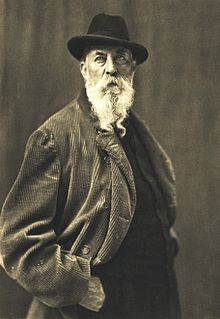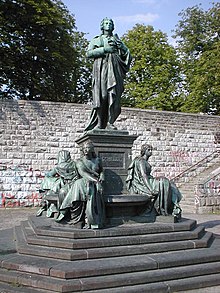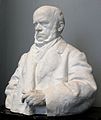You can help expand this article with text translated from the corresponding article in German. (April 2014) Click for important translation instructions.
|
| Reinhold Begas | |
|---|---|
 Photograph by Jacob Hilsdorf Photograph by Jacob Hilsdorf | |
| Born | (1831-07-31)31 July 1831 Schöneberg, Kingdom of Prussia |
| Died | 3 August 1911(1911-08-03) (aged 80) Berlin, Kingdom of Prussia, German Empire |
| Nationality | German |
| Education | Christian Daniel Rauch, Ludwig Wilhelm Wichmann |
| Known for | sculpture |


Reinhold Begas (15 July 1831 – 3 August 1911) was a German sculptor.
Biography
Begas was born in Berlin, son of the painter Carl Joseph Begas. He received his early education (1846–1851) studying under Christian Daniel Rauch and Ludwig Wilhelm Wichmann. During a period of study in Italy, from 1856 to 1858, he was influenced by Arnold Böcklin and Franz von Lenbach in the direction of a naturalistic style in sculpture. This tendency was marked in the group Borussia, executed for the facade of the exchange in Berlin, which first brought him into general notice.
In 1861 Begas was appointed professor at the art school at Weimar, but retained the appointment only a few months. That he was chosen, after competition, to execute the statue of Friedrich Schiller for the Gendarmenmarkt in Berlin, was a high tribute to the fame he had already acquired, and the result, one of the finest statues in the German metropolis, entirely justified his selection. Since the year 1870, Begas dominated the plastic art in the Kingdom of Prussia, but especially in Berlin. Among his chief works during this period are the colossal statue of Borussia for the Hall of Glory; the Neptune fountain in bronze on the Schlossplatz; the statue of Alexander von Humboldt, and the Kaiser-Wilhelm-Nationaldenkmal, all in Berlin; the sarcophagus of Emperor Frederick III in the mausoleum of the Church of Peace at Potsdam; and, lastly, the national monument to Emperor William I, the statue of Otto von Bismarck before the Reichstag building, and several of the statues in the Siegesallee.
Gallery
-
 Neptunbrunnen in Berlin, near Alexanderplatz
Neptunbrunnen in Berlin, near Alexanderplatz
-
 Bust of Adolph von Menzel, around 1875/76
Bust of Adolph von Menzel, around 1875/76
-
 Kaiser-Wilhelm- Nationaldenkmal (destroyed by the SED)
Kaiser-Wilhelm- Nationaldenkmal (destroyed by the SED)
-
 Carl Van Vechten in front of Mars
Carl Van Vechten in front of Mars
-
Bismarck-Nationaldenkmal
-
 Cenotaph of Bismarck (model)
Cenotaph of Bismarck (model)
-
 Prometheus
Prometheus
-
 Cenotaph of Frederick III, German Emperor. Located in the Berliner Dom.
Cenotaph of Frederick III, German Emperor. Located in the Berliner Dom.
-
 Susanna. 1869-72
Susanna. 1869-72
See also
References
- Attribution
 This article incorporates text from a publication now in the public domain: Chisholm, Hugh, ed. (1911). "Begas, Reinhold". Encyclopædia Britannica. Vol. 3 (11th ed.). Cambridge University Press.
This article incorporates text from a publication now in the public domain: Chisholm, Hugh, ed. (1911). "Begas, Reinhold". Encyclopædia Britannica. Vol. 3 (11th ed.). Cambridge University Press.
External links
![]() Media related to Reinhold Begas at Wikimedia Commons
Media related to Reinhold Begas at Wikimedia Commons
- 1831 births
- 1911 deaths
- Sculptors from Berlin
- Artists from the Province of Brandenburg
- Sculptors from the Kingdom of Prussia
- 20th-century German sculptors
- 20th-century German male artists
- 19th-century German sculptors
- 19th-century German male artists
- German male sculptors
- Recipients of the Pour le Mérite (civil class)
- German people of Belgian descent